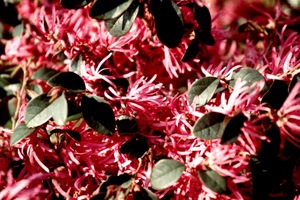Information Possibly Outdated
The information presented on this page was originally released on April 2, 2001. It may not be outdated, but please search our site for more current information. If you plan to quote or reference this information in a publication, please check with the Extension specialist or author before proceeding.
Burgundy Loropetalum wins medallion honors
By Norman Winter
MSU Horticulturist
Central Mississippi Research & Extension Center
Landscapers and homeowners are always looking for what is new and outstanding in shrub selection, and this year's Mississippi Medallion winner fits that category. The plant is the Burgundy Loropetalum.
This is a great new shrub in the witch hazel family. You might ask yourself, wasn't there a white-flowered loropetalum? There is, and at the risk of offending either nurserymen or gardeners who have them, I will say I have never seen one that I thought was attractive.

On the other hand, the Burgundy variety is among the showiest shrubs in the spring and summer landscape. Red loropetalums are fairly new to the United States, and now is a great time to plant some. One of the Burgundy Loropetalum's excellent landscape qualities is its evergreen foliage that is an unusual coppery-burgundy color that matures to an olive burgundy-green.
This is a low growing shrub that can be kept around 6 feet tall and 5 feet wide, forming a mound. Or you can let it be natural, where it will reach close to 12 feet in height with an 8-foot spread.
There have been records of some reaching 14 feet in height. This would mean that we have the possibility of developing a small tree that would have the color of the purple leaf plum except it would bloom periodically and stay evergreen.
You might want to try them like you would a barberry. Plant some large hollies as the background, then a group of loropetalums and some groundcover juniper in the foreground. They also work well in combination with azaleas.
Among the best features of the Burgundy Loropetalums are the gorgeous hot pink flowers. The pink-to-red flowers appear heavily in the spring and again several times throughout the year. Their petals look like little fingers.
The Burgundy Loropetalum prefers full sun, but can tolerate partial shade. Plant in well-drained, organic-rich beds that are slightly acidic. I like to emphasize the part about planting in beds. Whether planting loropetalums or any other shrub, put them in a bed instead of sticking them in a patch of turf.
The Burgundy Loropetalum is an environmentally-friendly plant, as it is not known to have any serious pests. The idea of putting a $5 plant in a $10 planting hole has merit when planting your loropetalum. Dig your hole two to three times as wide as the root ball and plant at the same depth that it is growing in its container. Backfill with the soil dug from the hole.
Successful establishment of new shrubs and trees in the landscape often depends on planting technique and care. This is your only chance to get your new plant off to a good start.
Just like in a container where we usually find successful plants growing, our shrub bed should be well-drained to moist, with loose, nutrient- and humus-rich soil, and with a layer of mulch added to prevent loss of moisture, deter weeds and moderate winter temperatures.
The Burgundy Loropetalum is becoming recognized as an outstanding plant all across the Southeast. If you plant some, you will see why it was chosen as a Mississippi Medallion award winner.






